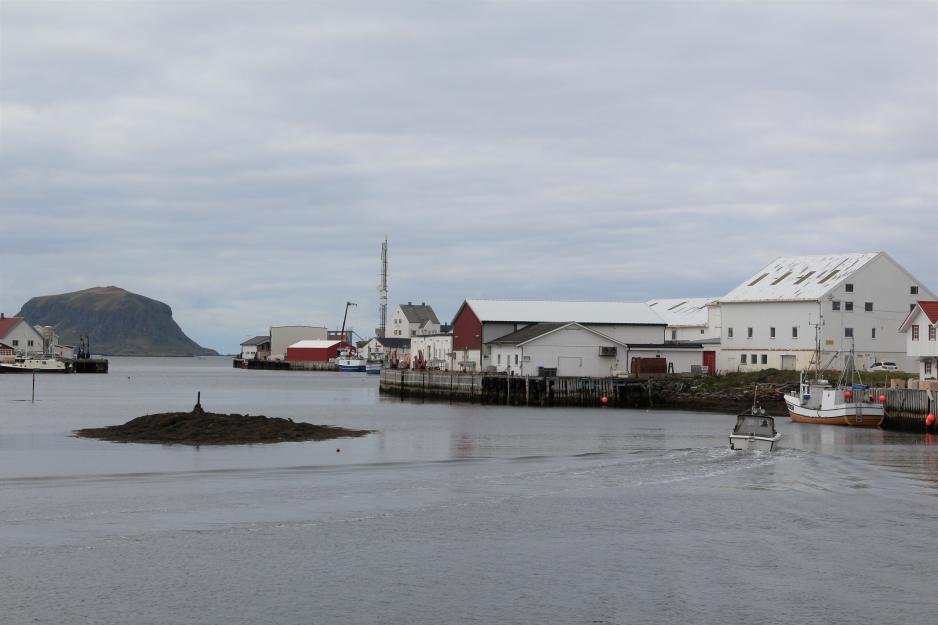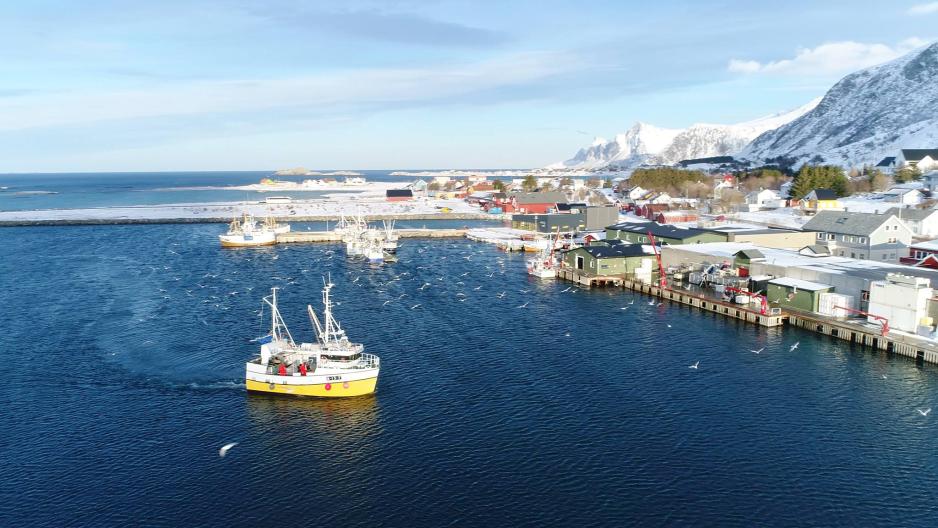"The Stockfish Sales Are on the Right Track"

The stockfish industry is very important for many towns in Lofoten, Northern Norway, such as here on Røst. In 2018, the five stockfish producers at Røst accounted for a total turnover of NOK 333 million. (Photo: Hilde Bye).
High export prices for stockfish in the autumn of 2022 led to slower sales, particularly in Italy. The high prices did however contribute to good margins and sales value, says stockfish producer Olsen from the Lofoten Islands.
Despite the fact that there was a decline in Norway's stockfish exports to the important market Italy in 2022, stockfish producers in Lofoten can report good sales of last year's fish.
"The stockfish industry had several good months, and December was particularly good with sales of over 300 tonnes of stockfish," Ole Olsen tells High North News. Olsen is the general manager at the stockfish company and exporter Sufi in Sund, one of the oldest fishing villages in the Lofoten Islands in Northern Norway.
New orders keep coming in, he says. The sale continues through the winter and until a new round of production of the dried cod is ready closer to August.
"Stockfish sales are now on the right track, but it is clear that the high price increase for export goods in the autumn of 2022 slowed down some of the sales in this period. This means that the warehouses in Italy are emptied and sales are moved to the winter season."
Olsen explains that the high prices led to overall lower sales last autumn than what has been normal. But despite the fact that there was a lower export volume, good prices also contributed to high export value and earnings. Last year, Sufi sold stockfish for approximately NOK 250 million.
Decrease in exports to Italy
"During last year, the industry saw a rather dramatic decline in sales to Italy. Exports to Croatia and the USA are going well, but they are still not as big markets as Italy," says Chairman Geir Børre Johansen of Røst Sjømat and AS Glea to High North News.
The export volume to Norway's most important stockfish export market, Italy, fell by 19 percent last year, to 2,000 tonnes. During the last 30 years, it is only in 2020 that there has been a lower export volume of dried fish products to Italy, according to figures from Norway's Seafood Council. In total, Norway exported more than 3,500 tonnes of stockfish to a value of NOK 730 million in 2022. The total volume fell by 18 percent, while the value was unchanged from 2021.
Johansen says it has been a normal, good year for Røst Sjømat and Glea. A large proportion of the stockfish the two companies have left in their warehouses will go into the market based on already concluded agreements. The two companies sell stockfish and stockfish products for between NOK 90 and 100 million annually.
Chairman and owner, Geir Børre Johansen, of the family business Røst Sjømat examines the stockfish. Johansen is also chairman of the Glea fish company, also on Røst island. (Photo: Hilde Bye).
High prices
"Things are going mostly well in the entire fisheries chain - from the value chain both at sea and on land. Whitefish is a price winner, although it is not a volume winner like salmon. There are good prices in the market, but we also see that we are facing resistance in both clipfish and stockfish sales now that prices have increased so much, especially in southern Europe", adds Johansen.
"The reduction in sales to Italy is due to several things, but particularly that the export price of stockfish has become so much higher. This is primarily due to the fact that the prices of the cod we buy from the boats increased dramatically in 2022. At the same time, the entire infrastructure has also become more expensive in terms of packaging and shipping. This makes it more expensive for consumers in Italy."
The higher prices for stockfish are a challenge in Italy. Like many others, Italians also experience lower purchasing power in line with the high inflation, explains seafood analyst Eivind Hestvik Brækkan in the Norwegian Seafood Council. The export price of whole stockfish of cod was NOK 229 per kilogram in 2022, NOK 18 NOK higher than the previous record year, which was 2019.
Record exports to the USA
Italy, the USA and Nigeria were the largest markets for stockfish from Norway in 2022. And Norway has never exported as much stockfish to the USA as it did last year, either in volume or value.
"The USA was also the country with the greatest increase in value last year, with an increase in export value of NOK 19 million, or 30 per cent, compared to the previous year," adds Brækkan of Norway's Seafood Council.

The stockfish export company Sufi in Lofoten operates fish reception facilities in several places in the Lofoten Islands. (Photo: Sufi AS).
High prices for cod during the winter fisheries
The fresh cod that is normally used for stockfish, saltfish, and clipfish production is bought from the fleet early in the winter fisheries season. The fresh fish is hung on fish flakes in the period January-March and hangs for around three months in early summer.
The producers have to take into account the high price level of the cod bought during the winter, as sales and earnings normally do not take place until late autumn.
The cod prices for the winter catch in 2022 increased considerably compared to 2021. For Sufi, the increase in the prices for cod was over 50 percent from one year to the next, explains Olsen in Sund.
Olsen is excited about this year's skrei fisheries, a migratory cod that is caught off the Norwegian coast from January to late March. The prices that fish producers have to pay for the cod are expected to be significantly higher now than in 2022.
"The fact that the prices are pushed up is connected, among other things, to how the fishing quotas are lower this year. There will therefore be less volume in total that can be purchased," he sums up.
"With a significant decrease in the cod quota this year, it is uncertain how large a volume of stockfish will be produced," says Brækkan of the Seafood Council.
Another point concerns where the skrei shows up. As High North News has previously mentioned, fewer fish was reported in the Lofoten ocean areas last year than what has been normal in the past.
Johansen at Røst says that there have been fewer fish in the Lofoten fishery in the last two years. Many of the boats also start fishing off the coast of Troms and Finnmark further north, where the cod arrives first and thus fish up large parts of the quota before the cod reaches Lofoten.
Stockfish in storage at Røst Sjømat when High North News visited the business in the fall of 2021. Chairman Johansen says that the quality of the fish is the most important determinant of its price. The raw material's quality when purchased - as well as drying conditions, drying time, and temperature, affects the final product's quality a lot, he says. (Photo: Hilde Bye).
Huge growth for clipfish exports
For the other traditional whitefish products, such as clipfish (salted and dried) and saltfish, large increases in value were also recorded.
According to the Seafood Council, there was a record-high export value for clipfish last year, NOK 805 million higher than the previous record year, which was 2019.
Norway exported over 85,000 tonnes of clipfish to a value of NOK 5.6 billion in 2022. The value increased by NOK 1 billion, or 23 percent, compared to 2021.
Portugal, Brazil, and Congo-Brazzaville were the largest markets for clipfish in 2022. Portugal had the greatest value growth last year, with an increase in export value of just over NOK 500 million compared to the previous year. The export volume to Portugal ended at 23,270 tonnes, which is 5 percent lower than the previous year.
Portugal is Norway's most important cod market
"Portugal consolidates its position as Norway's most important cod market. Measured in value, a whopping 33 percent of our total cod exports went to Portugal last year. For clipfish of cod, Portugal is even more dominant, and as much as 78 percent of the export of clipfish from cod went to Portugal last year," says seafood analyst Brækkan in Norway's Seafood Council.
Saltfish increased in both volume and value
Saltfish also had a large increase in value in 2022, as well as an increase in volume. Norway exported saltfish worth NOK 1.9 billion. The value increased by 59 percent compared to 2021, while the growth in volume was 16 percent. Portugal, Spain, and Italy were the largest markets for salt fish in 2022.

